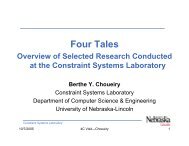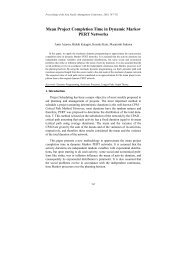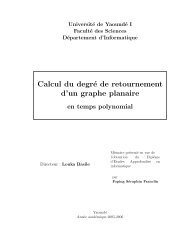Models for Global Constraint Applications - Cork Constraint ...
Models for Global Constraint Applications - Cork Constraint ...
Models for Global Constraint Applications - Cork Constraint ...
You also want an ePaper? Increase the reach of your titles
YUMPU automatically turns print PDFs into web optimized ePapers that Google loves.
1 Introduction<br />
<strong>Constraint</strong> programming [6] always has had a strong link to applications, with<br />
some of the early work driven by case studies and comparisons with other problem<br />
solving techniques [68, 27]. An overview of early CHIP [24] applications was<br />
already given in 1998 [28]. But it was some time be<strong>for</strong>e industrial applications of<br />
constraint programming did appear, with the earliest complete system probably<br />
described in [38]. This delay was not just caused by the on-going development<br />
of the solver technology, but also by the need to build application frameworks<br />
which allowed to put constraint applications into an end-user’s hands [37]. Some<br />
of these early applications suffered from limitations of the constraint engines,<br />
so that very large scale or highly combinatorial problems were not solved satisfactorily,<br />
leading <strong>for</strong> some to disappointment with the technology [23].<br />
An alternative was to look <strong>for</strong> ways to improve the reasoning power of the<br />
constraint systems, and of these approaches, the introduction of global constraints<br />
[2, 43, 13] was probably the most successful. <strong>Global</strong> constraints serve<br />
two purposes: on one hand, they allow more constraint propagation than a collection<br />
of primitive constraints, on the other hand they also simplify modelling<br />
of problems by providing high level constraint abstractions, which simplify the<br />
construction of large scale models.<br />
But with this added functionality also comes added complexity. Which<br />
model of a problem is the best one, and which problems can be modelled with<br />
constraints in the first place? There are a number of papers which consider<br />
constraint applications [71, 51, 41, 67], but they are more descriptive than prescriptive.<br />
In recent years, research on global constraints has gained much in popularity.<br />
There are many papers which deal with the algorithmic aspects of<br />
specific global constraints, improving complexity bounds or implementing a different<br />
<strong>for</strong>m of consistency <strong>for</strong> a known constraint. There are also papers which<br />
introduce new global constraints, or extend old ones in novel ways. Finally<br />
there is an extensive study of generic methods <strong>for</strong> building global constraints<br />
from abstract properties. The global constraint catalog [12] contains 235 entries<br />
(as of May 2005). But there is relatively little work reported on what to<br />
do with them [64, 46, 66, 17, 61, 49, 16, 48, 58]. A series of tutorials at the<br />
PAP/PACT/PACLP series of conferences on modelling with global constraints<br />
is not readily accessible [53, 54, 55, 56, 57].<br />
This paper tries to present a few case studies on how global constraints<br />
can be used in modelling and solving complex problems. It complements the<br />
overview [63], which describes some of the system aspects of other constraint<br />
applications.<br />
The paper is structured in the following way: We are now at the end of the<br />
introduction, which provided some background on global constraints and the<br />
applications that use them. We will next look at three case studies from commercial<br />
constraint applications, and see how global constraints make it possible<br />
to build very concise, yet powerful models <strong>for</strong> them.<br />
• The first (section 2) is the APACHE [25] system, an airport stand allocation<br />
application which was initially built (without global constraints) as<br />
a demonstrator <strong>for</strong> AirFrance, and which eventually was implemented at<br />
an airport in Korea [63].<br />
3









